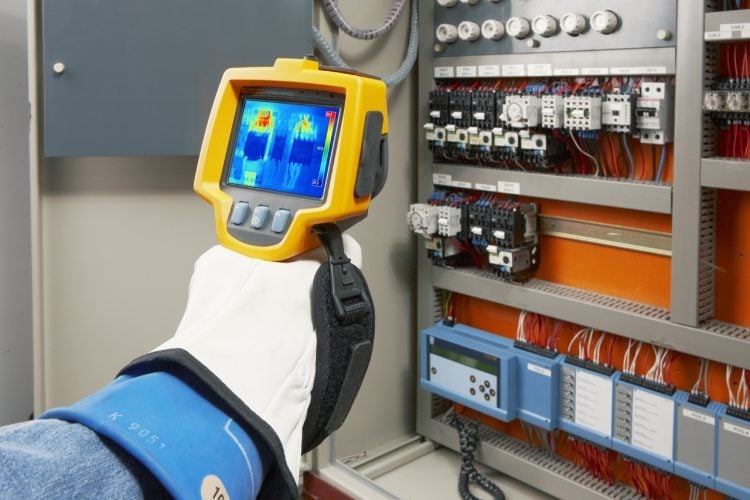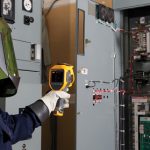
Carelabs is authorized provider of Electrical Installation’s Study, Analysis, Inspection, and Certification services in UAE, and offer Electrical Thermography Inspection Services.
Electrical and mechanical systems can run into problems without warning. Too often, equipment are allowed to run until it malfunctions and needs either serious repairs or replacement, which can cost a lot of money. There are ways you can prevent this. Organizing an electrical inspection is the best way to protect equipment from damage. Electrical thermography inspection is the process of photographing the exchange/loss of heat in machinery and facilities. It analyses electrical faults like loose connections and over loaded circuits
Following are Benefits of Using Electrical Thermography Inspection
- It makes it possible to conduct electrical thermal imaging surveys with no intrusion.
- It helps to reduce the number of costly and catastrophic equipment failures and unscheduled plant shutdowns
- It can reduce typical visual examinations and tedious manual inspections and are especially effective in long-range detection situations.
- It can identify areas that are abnormally hot or cool
- Reduce unscheduled downtime
- It assures safety by detecting electrical problems in good time and avoiding fires caused by overloaded circuits or faulty wiring.
- Inspections using infrared thermography will help in detecting problems and allow for repairs. When equipment is fixed in good time, thus increasing equipment life, productivity will increase, and you will realize significant financial savings.
- When you can deal with electrical problems, all your systems will operate optimally. This will allow you to deliver quality products, a factor that will not only earn you trust but also boost your business.
- Compared to manual inspections, infrared thermography will not require you to interrupt services during the inspection. This will reduce losses and improve your cash flow. In case you have commercial insurance that protects against interruptions, you will pay lower premiums for the coverage.
How Electrical Thermography Inspection is Performed?
For electrical systems, infrared instruments are generally used to identify current-carrying conductor anomalies. Over time, connections become loose from cycling temperature variations due to loading fluctuations and vibration associated with electrical equipment operation along with many other factors. Higher resistances occur across these problem connections, and heat is created based on the associated losses. Heat is indirectly measured by the objects emissivity using the infrared instrument
Electrical thermal inspection is done using a thermal imaging camera. The camera is pointed at the electrical panel, or electrical circuit you need. The screen on the equipment shows if there are any hot spots in the circuits. It also shows the temperature. The laser pointer shows the exact location where the temperature is higher than other. Then we can remove the panel and inspect. Qualitative inspection focuses on temperature differences as opposed to actual temperature
Loose connections, corrosions and load imbalances etc are resistive to the flow of electrons and cause connections or circuits to heat up. This is the energy you are paying for but getting no value from.
Following are few of the equipment we provide electrical infrared thermography inspection services
- Switch Gear
- Transformers
- Service Disconnects
- Transfer Switches
- Bus Runs
- Motors / Pumps / Bearings
- Lighting / Heating Contactors
- Motor Control Centers
- Breaker Panels
- Starters
- UPS Equipment
- Chillers and Roof Top HVAC Equipment
- VFDs
NFPA 70B, Recommended Practice for Electrical Equipment Maintenance, published by the NFPA, provides a listing of maintenance and equipment testing intervals in Annex I. Businesses with high electrical demands should have a thermographic scan performed at least annually on critical systems, such as circuit panels, switchgears, and transformers. Based on the scan results, a schedule to rescan should be based on the types of equipment, power consumption, and age of the electrical systems. A qualified electrician can assist the property owner in determining what and how often to conduct scans. However it is recommended to do the inspections within a year to detect faulty system on new installations
Because thermographic imaging equipment is complex, persons performing evaluations require special training. In addition, there is potential exposure to “live” electrical components. As such, unless the company is large or sophisticated, these inspections are commonly performed by consultants.
In addition to the typical application thermography is also used for the following inspections
Transformers
Infrared imaging of the transformer can often detect fluid levels and radiator convection cooling problems
Switchgear
The integrity of outdoor switchgear assemblies is often compromised by defective strip heaters. The strip heaters temperature changes increase the switchgear temperature slightly above ambient in order to prevent condensation during daily or seasonal. The functionality of these strip heaters and their effectiveness to perform this duty can be determined by performing thermal imaging of the switchgear enclosures
Low Voltage Duct
Low-voltage bus duct assemblies are popular for facility applications that require distributing high currents for long distances due to their lower installation cost compared to conduit and cable. Although very reliable, these assemblies are very difficult to test by conventional methods due to limited access caused by their construction. Infrared inspections are one of the few technologies that can help identify bus segment contact problems at joints. Infrared inspections must generally be performed by scanning the outside bus duct enclosure. Although significant air gaps exist between the bus and enclosure, this technique has been successful in detecting connection problems.
Noncurrent-carrying Items
Many times a metallic structural support, cableway, or cable tray assembly, none of which should be carrying current will indicate heating that is apparently from electrical current flowing. Field measurements of hundreds of amperes have been seen numerous times and are most commonly the result of excessive eddy currents caused by inductive heating. This heating effect can cause the surface temperature to rise well beyond the boiling point of water, potentially presenting a burn hazard to personnel or the deterioration of other substances in close proximity.
The infrared survey is a great detection tool for potential problems, but bonus electrical tests should be performed in order to confirm faults in the circuit. It is really easy to have a positive thermal image. Therefore, other measurements such as current readings, harmonic analysis, power factor, should be performed for clarification. These additional tests are mandatory as certifiable test results may be required for analytical purposes.
Lastly, the infrared survey remains one of the best overall tools for detecting potential electrical problems. The popularity of the technology and the low cost of equipment have allowed non-experts to implement infrared survey programs. However, the additional cost associated with upper-end equipment and experienced technicians with certified training may very well be worth every penny when important decisions are made based upon infrared survey result.











